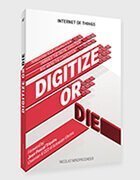
marrakeshh - Fotolia
'Digitize or Die': Embrace IoT digital transformation or perish
In his book, Schneider Electric's EcoXpert program global vice president decodes how IoT digital transformation strategies differentiate winners and losers.
What do Polaroid, Nokia and Blockbuster all have in common -- besides all being huge companies that sank? They didn't digitize -- so they died.
In his new book, Digitize or Die, Schneider Electric internet of things (IoT) guru Nicolas Windpassinger lays out the case for all companies to find their IoT digital transformation groove. According to Windpassinger, global vice president of the company's EcoXpert partner program, organizations that don't embrace IoT to improve sales, services and data mining insights also risk death.
The book, by the way, is part tech manual for designing an IoT project, part change management book for non-techies. It's also part inspirational success story, highlighting Schneider Electric's experiences building its own IoT digital transformation projects and new profit centers.
Right now, two kinds of companies are avoiding IoT: The first sticks its head in the sand, ignoring it completely.
The other, those "milking the cow," as Windpassinger puts it, deliberately avoid IoT and other potential digital transformations of operations or services because they are capitalizing on their current market position without the overhead of planning, purchasing and rolling out IoT projects. While they will financially beat their competition for a while because they're not moving forward, eventually, both groups will end up on the same corporate trash heap as Blockbuster, he theorizes in the book.
Scope an edge project
But the problem Windpassinger tackles is one many CRM professionals must solve before moving forward with large, new, unknown technology initiatives: scoping a small project that can provide some wins for a newly digitized operation before the company invests too much capital and bandwidth into something that might fail.
 Digitize or Die, by
Digitize or Die, by
Nicolas Windpassinger
Biting off more IoT than your company can chew, or "U-turning the mothership," as Windpassinger calls it, can be just as deadly as doing no IoT projects at all. Examples of edge projects -- small pilots that grew into platforms from the edge -- can include up-sells or service enhancements that don't compete head to head with bread-and-butter product lines.
Where were these far-flung reaches of Schneider Electric's product lines with which the IoT team got the company started with new service lines? Schneider, which is striving to be carbon-neutral by 2030, has built three IoT platforms to sell power conservation services to customers.
- A consumer-facing home intelligence system with sensors that focus on live power consumption and give feedback on how to conserve energy without reducing what the homeowner deems comfort. The system also utilizes applications to give users remote control over lamps that might have been left on when they left the house -- a service the consumer can't perform themselves.
- A commercial IoT platform that helps restaurants prevent food loss by monitoring and reporting refrigerator temperatures and notifying the affected parties over secure channels when temperatures move outside of predetermined thresholds. This is a service the chefs wouldn't pay to set up, due to the infrastructure and having to endure implementation headaches -- but they'll pay Schneider a monthly subscription fee to operate the service.
- A program of IoT valves that Schneider sets up and manages in commercial buildings to help maintenance managers monitor and detect water and gas leaks.
What do they all have in common? Windpassinger writes that, as organizations plan their IoT strategies to enhance product and service lines and move ahead of dying competitors, "Each individual move should be equal to a customer value proposition/gain. The sum of all moves should form together the targeted customer experience."
IoT transformation methodology
After that comes tech crunching, which marketing and sales managers must hash out with their IT leaders. Figuring out the rollout of an IoT digital transformation project -- from pilot to determining which customers and which devices will make the most sense, as well as how data will be collected, stored and analyzed at your company -- takes a team with representatives from several sides of the operations who must put their heads together.
Big-picture decisions, such as how to monetize raw data -- the rawer, the more potentially profitable for imaginative organizations, according to Windpassinger -- will be part of the project design, as will small decisions, such as what channel will be most appropriate for the devices on your chain, including Wi-Fi, Bluetooth, near-field communications or radio frequency ID. After that, the project team must add blockchain components to validate and reward results in a secure system of record.
Keeping the customer as the first step when designing an IoT upgrade to one of your company's product or service portfolio items is the key to success. From there, all blessings flow, such as monetizing IoT digital transformation, competitive differentiation and Agile project design that can be replicated with other products and services your company sells.
"If you are obsessed to solve problems for your customers, to help them in their everyday operations and bring a strong contribution to their business, IoT will be an incredible opportunity," Windpassinger writes.
Dig Deeper on Marketing and sales
-
![]()
University of Lincoln undergoes edge datacentre modernisation project
-
![]()
Schneider Electric makes bid to acquire Atos Group's EcoAct sustainability consultancy business
-
![]()
Hardware and commercial flexibility issues slow down IoT adoption
-
![]()
Schneider Electric, NTT team to trial private wireless network in IoT environments






